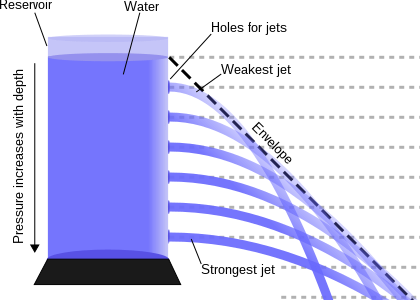Torricelli's law
Torricelli's law, also known as Torricelli's theorem, is a theorem in fluid dynamics relating the speed of fluid flowing out of an opening to the height of fluid above the opening.

Torricelli's law states that the speed of efflux, v, of a fluid through a sharp-edged hole at the bottom of a tank filled to a depth h is the same as the speed that a body (in this case a drop of water) would acquire in falling freely from a height h, i.e. , where g is the acceleration due to gravity (9.81 N/kg near the surface of the earth). This last expression comes from equating the kinetic energy gained, , with the potential energy lost, mgh , and solving for v.
The law was discovered (though not in this form) by the Italian scientist Evangelista Torricelli, in 1643. It was later shown to be a particular case of Bernoulli's principle.
Derivation
Under the assumptions of an incompressible fluid with negligible viscosity, Bernoulli's principle states that:
where v is fluid speed, g is the gravitational acceleration (9.81 m/s2), h is the fluid's height above a reference point, p is pressure, and ρ is density. Define the opening to be at h=0. At the top of the tank, p is equal to the atmospheric pressure. v can be considered 0 because the fluid surface drops in height extremely slowly compared to the speed at which fluid exits the tank. At the opening, h=0 and p is again atmospheric pressure. Eliminating the constant and solving gives:
Experimental evidence
Torricelli's law can be demonstrated in the spouting can experiment, which is designed to show that in a liquid with an open surface, pressure increases with depth. It consists of a tube with three separate holes and an open surface. The three holes are blocked, then the tube is filled with water. When it is full, the holes are unblocked. The lower a jet is on the tube, the more powerful it is. The fluid's exit velocity is greater further down the tube.[1]
Ignoring viscosity and other losses, if the nozzles point vertically upward then each jet will reach the height of the surface of the liquid in the container.
Total time to empty the container
Consider a cylindrical container containing water to height h is being emptied through a tube freely. Let h be the height of water at any time. Let the velocity of efflux be
Now, where A and a are the cross sections of container and tube respectively, dh is the height of liquid in container corresponding to dx in the tube which decreases in same time dt.
is the time required to empty the water from height h1 to h2 in the container, where h1 > h2. This formula can be used to calibrate a water clock.
Clepsydra problem

A clepsydra is a clock that measures time by the flow of water. It basically consists of a pot with a small hole at the bottom through which the water can escape. The amount of escaping water gives the measure of time. As given by the Torricelli's law, the rate of efflux through the hole depends on the height of the water; and as the water level diminishes, the discharge is not uniform. A simple solution is to keep the height of the water constant. This can be attained by letting a constant stream of water flow into the vessel, the overflow of which is allowed to escape from the top, from another hole. Thus having a constant height, the discharging water from the bottom can be collected in another cylindrical vessel with uniform graduation to measure time. This is an inflow clepsydra.
Alternatively, by carefully selecting the shape of the vessel, the water level in the vessel can be made to decrease at uniform rate. By measuring the level of water remaining in the vessel, the time can be measured. This is an example of outflow clepsydra. Let y = f(x) be monotonically increasing function along the x-axis. When it rotates around the y-axis, it forms a bowl shape. We want to find the function f(x), such that, when the water is draining from a small hole of area a at the bottom of this bowl, the change in water level is constant, dy/dt = c.
At a given height y, let the area of the water surface be . The instantaneous rate of change in water volume is given by
Similarly, the rate of outflow from the bottom is
from Torricelli's law. From these two equations,
where
References
Further reading
- T. E. Faber (1995). Fluid Dynamics for Physicists. Cambridge University Press. ISBN 0-521-42969-2.
- Stanley Middleman, An Introduction to Fluid Dynamics: Principles of Analysis and Design (John Wiley & Sons, 1997) ISBN 978-0-471-18209-2
- Dennis G. Zill, A First Course in Differential Equations (2005)
See also
- Pascal's law
- Fluid dynamics
- Darcy's law
- Dynamic pressure
- Fluid statics
- Hagen–Poiseuille equation
- Helmholtz's theorems
- Kirchhoff equations
- Knudsen equation
- Manning equation
- Mild-slope equation
- Morison equation
- Navier–Stokes equations
- Oseen flow
- Pascal's law
- Poiseuille's law
- Potential flow
- Pressure
- Static pressure
- Pressure head
- Relativistic Euler equations
- Reynolds decomposition
- Stokes flow
- Stokes stream function
- Stream function
- Streamlines, streaklines and pathlines
- Bernoulli's principle














![{\displaystyle A=\pi x^{2}=\pi [f^{-1}(y)]^{2}}](https://wikimedia.org/api/rest_v1/media/math/render/svg/966b01a0edd90585ac4103cb322aa6ea449dbaf8)
![{\displaystyle {\frac {dV}{dt}}=A{\frac {dy}{dt}}=\pi c[f^{-1}(y)]^{2}.}](https://wikimedia.org/api/rest_v1/media/math/render/svg/3bc6b3d89bb8129f9ea62b13b83a1c853719dadc)

![{\displaystyle {\begin{aligned}a{\sqrt {2gy}}&=\pi c[f^{-1}(y)]^{2}\\\Rightarrow \quad y&=kx^{4},\end{aligned}}}](https://wikimedia.org/api/rest_v1/media/math/render/svg/37a0cf84454f16b67885605814ae2faa1aeeff2d)
